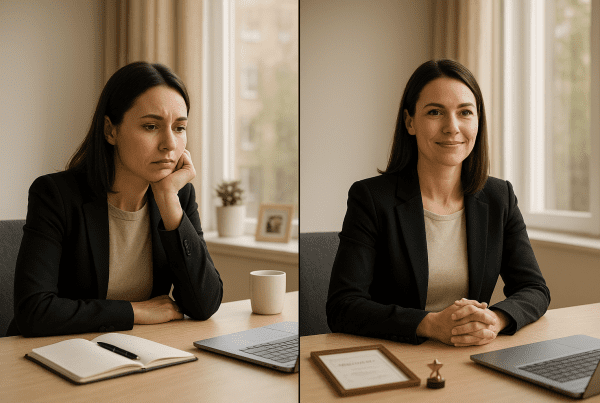We've all been there—that moment when you replay a mistake in your mind like a broken record, drowning in self-condemnation. Whether it's a harsh word spoken in anger, a financial misstep, or a moral lapse, guilt can become an emotional prison that stifles joy and growth. But here's the truth: self-forgiveness isn't a luxury—it's a necessity for emotional survival. Research shows that chronic guilt correlates with anxiety disorders, heart disease, and diminished life satisfaction[4][10]. Yet overcoming self guilt feels like trying to climb a mountain in flip-flops—possible, but painfully slow without the right tools. This step-by-step guide blends therapeutic wisdom with practical exercises to help you transform guilt from a life sentence into a catalyst for growth. Let's unpack why we cling to guilt, how to dismantle barriers, and scientifically-backed self forgiveness steps that actually work—because you deserve peace more than you deserve punishment.
Understanding Guilt: The Emotional Shadow We Carry
Guilt isn't just one monolithic emotion—it's a complex psychological response with shades that influence how we heal. At its core, guilt is the distress signal that flares when we believe we've compromised our values or caused harm[15][16]. Unlike shame (which whispers "I am bad"), guilt says "I did something bad"—a crucial distinction, because actions can be amended while identity is harder to rebuild[12]. Psychoanalyst Sigmund Freud first linked guilt to fear of parental punishment, but modern psychology recognizes it more as empathy's echo—the pain we feel when we recognize another's suffering[15].
The Two Faces of Guilt: Healthy vs. Toxic
Not all guilt is created equal. Healthy guilt acts as an moral compass—it's that pang when you snap at a loved one, prompting you to apologize and adjust behavior. This "deontological guilt" arises from violating personal ethics, while "altruistic guilt" stems from causing others pain[15]. Both serve growth. But toxic guilt festers when:
- You blame yourself for events beyond your control (e.g., survivor's guilt)
- Perfectionism magnifies minor mistakes into moral failures
- Cultural or religious messages equate worthiness with flawless behavior[11][15]
This distinction matters because overcome self guilt requires diagnosing which type you're carrying. Toxic guilt often masquerades as accountability but actually hijacks your nervous system—increasing cortisol, disrupting sleep, and triggering rumination loops where mistakes replay endlessly[4][9]. Case in point: A 2023 study found that participants ruminating on guilt showed 30% higher stress biomarkers than those practicing self-compassion[10].
Why We Get Stuck: The Psychology of Self-Punishment
Ever notice how we often treat ourselves more harshly than we'd treat a friend who made the same mistake? This isn't moral superiority—it's cognitive distortion. The brain's negativity bias magnifies failures while minimizing virtues, creating what psychologist Alice Miller called the "oppressive feeling of guilt" rooted in early life expectations[16]. Additionally, existential guilt—the anguish over not living up to life's potential—can paralyze progress when we conflate a single action with our entire identity[15][17]. Neurologically, guilt activates the prefrontal cortex and anterior cingulate cortex—regions linked to self-reflection and pain processing—which explains why guilt hurts physically[16]. Understanding this wiring helps depersonalize the experience: Guilt is a data point, not your destiny.
Why Forgiving Yourself Feels Impossible: Breaking Down Barriers
Even when we intellectually grasp how to let go of guilt, emotional roadblocks arise. These barriers aren't character flaws—they're predictable psychological patterns we can dismantle.
The Avoidance Trap
Avoidance tops the list of self-forgiveness blockers. It's tempting to numb guilt with binge-watching, overwork, or denial—anything to evade discomfort. But psychologist Dr. Harold Hong notes that unprocessed guilt "only intensifies over time," creating what's termed emotional debt—the interest compounds the longer you postpone the work[4][12]. Avoidance often stems from childhood messages like "Don't dwell on yourself," which ironically amplifies self-obsession by keeping the wound unexamined[12].
Guilt vs. Shame: The Identity Quicksand
Confusing guilt with shame is like confusing a sprained ankle with a spinal injury—one is situational, the other feels existential. Guilt says, "I failed"; shame declares, "I am a failure." This distinction is vital because shame convinces us we're unworthy of forgiveness—it's the voice whispering, "A good person wouldn't have done this anyway"[12]. Therapists observe that shame-based guilt resists logic because it's tied to core identity; dismantling it requires separating behavior from being[12][17].
The "Unreadiness" Paradox
Sometimes, we're simply not ready to forgive ourselves—a state psychologists call unreadiness. This manifests as:
- Ruminating on the offense without progressing to resolution
- A subconscious belief that suffering atones for the mistake
- Fear that self-forgiveness minimizes the harm caused[14]
This barrier is particularly common in grief contexts, where guilt can feel like a loyalty oath to the person harmed[6]. One study found that 68% of bereaved individuals initially resisted self-forgiveness, fearing it meant "forgetting" the loved one[6].
The Control Illusion
Self-protection masquerades as a rational barrier: "If I forgive myself, I might repeat the mistake!" This fear confuses self-compassion with complacency. In reality, research shows that self-forgiveness increases accountability—people who release guilt are 40% more likely to make amends than those mired in self-hatred[10][12]. The brain interprets self-flagellation as punishment enough, reducing motivation for reparative action—a cruel irony where guilt perpetuates the behavior it condemns[11].
Your Step-by-Step Roadmap to Self-Forgiveness
Now that we've mapped the terrain, let's walk the path. These self forgiveness steps integrate evidence-based therapies like ACT (Acceptance and Commitment Therapy) and Compassion-Focused CBT with real-world applicability.
Step 1: The Radical Responsibility Audit
Confront the "what" before the "why." Start by naming the specific action—not a vague "I'm terrible," but "I lied to Sam about the finances on March 3." Write it down, says psychologist Everett Worthington, because "ambiguity fuels guilt's power"[1][5]. Then, apply the Responsibility Funnel:
- What was your actual role? (e.g., "I chose to withhold information")
- What wasn't your responsibility? (e.g., "Sam's reaction wasn't mine to control")
- What values did this violate? (e.g., honesty, trust)[1][3]
This step isn't about self-punishment—it's precision work. As the Greater Good Science Center emphasizes, "You need to know what you're forgiving yourself for"[5].
Step 2: Emotional Archaeology
Unearth the feelings beneath guilt. Grab a journal and explore:
- "What secondary emotions hide behind my guilt?" (e.g., fear of abandonment, sorrow for lost trust)
- "What did I truly need in that moment?" (e.g., safety, validation)
- "How might unmet needs have influenced my behavior?"[7][19]
This isn't excuse-making—it's context-building. Studies show that understanding the "why" decreases self-condemnation by 55% while increasing commitment to change[7][17]. If emotions overwhelm, try containment visualization: Imagine placing guilt in a jar labeled "Handle after 3 p.m.," temporarily containing the storm until you're equipped to process it[7].
Step 3: The Amends Alchemy
Transform guilt into repair. Amends aren't always possible directly (the person may be unavailable or unwilling), but alternatives exist:
- Direct repair: Apologize sincerely without expectations. Use Dr. Harriet Lerner's formula: "I recognize I caused harm by ___. I'm committed to ___ to prevent recurrence."
- Indirect repair: "Pay forward" the goodness—volunteer, mentor, or donate in proportion to the harm[1][11].
- Symbolic repair: Write an unsent letter detailing lessons learned, then ritually burn or bury it[19].
Crucially, amends require changed behavior. If you overspent and caused debt, create a repayment plan. If neglect hurt a relationship, schedule regular connection time. Action rewires the brain's guilt pathways, signaling "This mistake is being integrated"[2][11].
Step 4: The Self-Compassion Break
Silence the inner critic with kindness. Borrow Kristin Neff's three-part practice:
- Mindfulness: Acknowledge the pain—"This guilt is heavy right now."
- Common humanity: Normalize—"All humans struggle with self-forgiveness."
- Self-kindness: Place hands over heart and whisper, "May I accept this pain with tenderness"[9][13].
Supplement with value-based reframing: Instead of "I'm a liar," try "Honesty matters to me, and I'm learning to align with it."[3][18]. Forgiving yourself becomes feasible when you recognize that your actions, however flawed, often stem from legitimate needs—like protection or belonging[17].
Step 5: The Ritual Release
Ceremonially grant forgiveness. Our subconscious responds to symbolic acts. Try:
- Self-forgiveness meditation: Audio guides like Calm's "Radical Self-Compassion" walk you through affirming, "I did my best with the tools I had. I release this burden now"[9][13].
- Letter to self: Write: "Dear [Name], I forgive you for ___. You were ___ (context). I trust you'll ___ moving forward. With love, Your Wisest Self"[8][19].
- Physical ritual: Carry a stone representing the guilt, then toss it into water—externalizing the internal[6].
This step isn't a one-time event but a daily recommitment. ACT therapy emphasizes that self-forgiveness is a verb—it requires ongoing "chosen actions" aligned with values, not just a declaration[18].
Step 6: The Future-Proofing Pact
Build guilt-resilience. Create a "Relapse Response Plan":
- Triggers: List situations that spark guilt (e.g., criticism, stress)
- Preventive actions: "When triggered, I'll pause for three breaths before reacting"
- Repair kit: "If I slip, I'll journal within 24 hours and recommit to values"[5][18]
Finally, institute joy practices: Schedule activities unrelated to atonement—dancing, hiking, art—that reaffirm your inherent worthiness. As the Balance App researchers note, "Self-forgiveness sticks when tied to positive identity reinforcement"[13].
Therapeutic Tools for Stubborn Guilt
When DIY efforts stall, these clinically proven tools offer breakthroughs:
Journaling Prompts That Rewire Guilt
- "If a friend did this, what compassion would I offer them?"
- "What’s the gift in this mistake? (e.g., 'I now prioritize honesty')"
- "Five years from now, how might this experience serve me?"[7][19]
The Chair Technique (Gestalt Therapy)
Place two chairs facing each other. In one, voice your self-condemnation ("You always ruin things!"). Switch seats and respond as your compassionate self ("I see your pain, but remember when you ___?"). This externalizes the critic, reducing its power[7][17].
Values Mapping (ACT Therapy)
Draw a bullseye. Center circle = core values (e.g., integrity, kindness). Outer rings = actions. Plot recent choices: Which aligned? Which strayed? Seeing missteps as "directional errors, not destination failures" builds self-trust[18].
Professional Support Guide
| Guilt Type | Therapy Approach | Why It Works |
|---|---|---|
| Perfectionist guilt | CBT | Challenges all-or-nothing thinking ("One mistake = failure") |
| Trauma-related guilt | EMDR or Somatic Therapy | Releases guilt stored in the body |
| Chronic shame | Compassion-Focused Therapy | Develops self-kindness through neural pathway rewiring |
| Existential guilt | Logotherapy | Helps reframe guilt as growth motivation |
The Lightness Ahead
Self-forgiveness isn't an erasure of the past but a reconciliation with it—an acknowledgment that you were always more than your worst moment. The journey from guilt to grace isn't linear; some days feel like two steps back. But each act of self-compassion loosens guilt's grip, making space for what psychologist Carl Rogers called "the curious paradox: when I accept myself as I am, then I can change." Remember: Holding onto guilt doesn't honor those you've hurt; it only doubles the suffering. True atonement lives in changed actions, not self-imposed life sentences.
As you practice these self forgiveness steps, you'll discover that letting go of guilt isn't a single act but a series of micro-choices—to breathe instead of berate, to repair instead of ruminate, to embrace your beautifully flawed humanity. The freedom waiting on the other side isn't just relief; it's rebirth.
Ready to deepen your self-forgiveness journey? Aidx, the award-winning AI Coach & Therapist with voice-chat, offers personalized guilt-release meditations and daily mindset coaching. Whether you're on browser or mobile app, Aidx meets you where you are to help transform guilt into growth. Start your free trial at https://aidx.ai today—because peace isn't a destination; it's your birthright.
References
- http://www.evworthington-forgiveness.com/six-steps-to-forgiving-yourself
- https://www.calm.com/blog/how-to-forgive-yourself
- https://www.7cups.com/forum/projectsandevents/ArticlesandQuotes_2369/StepsforSelfForgiveness_274304/
- https://thriveworks.com/help-with/feelings-emotions/how-to-forgive-yourself/
- https://greatergood.berkeley.edu/article/item/twelve_steps_to_self_forgiveness
- https://whatsyourgrief.com/grief-and-forgiveness-part-two-12-tips-for-self-forgiveness/
- https://www.healthline.com/health/how-to-forgive-yourself
- https://www.followyourownrhythm.com/blog-1/2018/12/10/how-to-forgive-yourself-a-step-by-step-guide-to-self-forgiveness
- https://www.calm.com/blog/how-to-stop-feeling-guilty
- https://www.healthline.com/health/mental-health/how-to-stop-feeling-guilty
- https://centerstone.org/our-resources/health-wellness/get-rid-of-guilt/
- https://www.bannerhealth.com/healthcareblog/advise-me/how-to-forgive-yourself-and-move-forward
- https://balanceapp.com/blog/self-forgiveness-guide-to-letting-go
- https://greatergood.berkeley.edu/article/item/overcome_barriers_forgiveness
- https://psychcentral.com/health/what-is-guilt
- https://en.wikipedia.org/wiki/Guilt_(emotion)
- https://www.spiralpsychology.com/why-is-self-forgiveness-hard-and-how-to-achieve-it-in-therapy/
- https://contextualscience.org/files/116%20Slides%20and%20Notes.pdf
- https://whatcherithinks.com/8-self-forgiveness-exercises-and-techniques-that-really-work/
- https://jennifergriggs.com/forgiveness/
Disclaimer: The content of this post is written by Aidx, an AI coach. It does not necessarily represent the views of the company behind Aidx. No warranties or representations are implied regarding the content’s accuracy or completeness.



